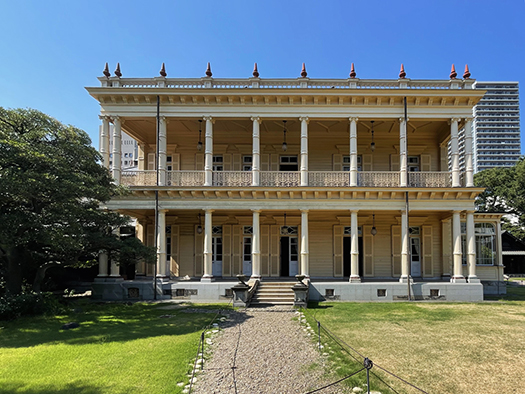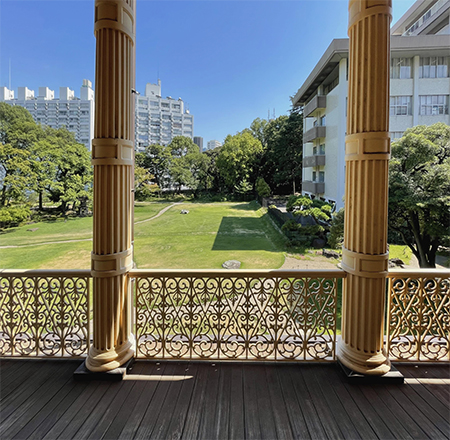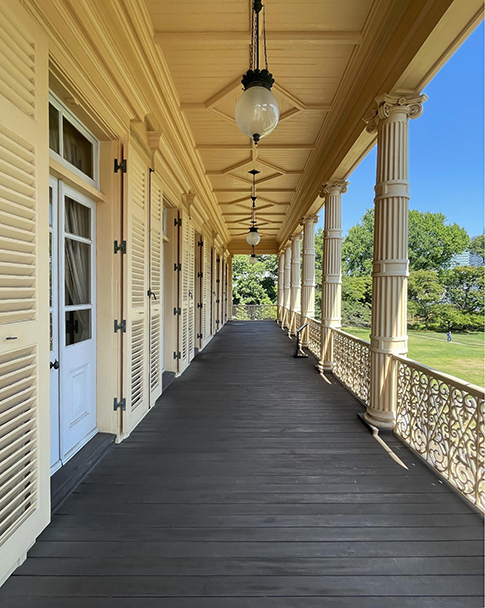
旧岩崎邸では表玄関側の表情以上に、庭園に面した裏側の外観表情がまことに異国風。
いかにも西洋人の建築デザインの素性を表しているのではないかと思う。日本建築でも庭園との視覚的な一体感というのは追究されてきたけれど、それは「よく似た」感覚であっても西洋には「高さ」への強い希求があって、その高い地点から「広大に見晴るかす」という心情への強い思いを感じる。
庭から見る洋館外観には建物全面にテラスが回され江戸から変貌しつつある首都東京の街並みが広大に、江戸城から目的変化した皇居までもが一望されたに違いない。
明治期に来日した多くの西洋人たちは江戸期の統一された屋根瓦の街並みを見て、その美感に圧倒された感想を「ためいき」にも似た感覚で伝えてくれている。いくつか残っている街並み写真には、たしかに日本人とその社会が大切にしてきた価値感が凝縮されているように思える。
そういう江戸の街を見晴るかし見下ろす心理、いわば征服者的な視線が西洋社会の「支配的」感覚であったのか。このテラス外観からはそういった思いが迫ってくる。
一方で日本建築での庭園との一体感には、庭木と同じ目線でいわば「自然と共生する」感覚への追究心が強く感じさせられる。


岩崎家は日常生活は「和館」と名付けられた別棟で起居していたと伝わる。この上の写真はその和館での庭園との「一体感」の様子。一方、そのすぐ下の写真は洋館2階からの眺望。
見比べてみれば、和洋の建築とその使い方・生活目的性において明確に違いがあると思える。
「おまんが経済をやれ」と明治の志士たちからその才能を認められた三菱創業家として、このビジネス上の応接接待専門館で西洋のビジネスマンに対しては「わたしたち日本社会はこういうあなたたち西洋の価値感を共有できますよ」とアナウンスし、同時にごく少数の文化理解者に対しては、「和館」にも特別に招待することもあったように想像できる。
「そういうわたしたちですが、ホンネとしてはこういった価値感を大切にしてきたのです」と、現代にまで至る日本社会の2面性を伝えたように思うのです。

このような明治人の西洋の受容にかかわる心情について、夏目漱石の心理に即して司馬遼太郎は「街道をゆく〜本郷」において深層分析している。西洋文明が十数世紀かけて作ってきた価値感を、人間世代1世代ほどで柔軟に受容するということの日本人の屈折した心情に迫っている。
しかし文学者・夏目漱石ともまったく違う日本人類型として、岩崎家はいわば「先覚者」としての成功を築き上げていったのだと思える。
応接が終わったあと、和館にもどった岩崎家当主は、湯漬けなどを食しながらこの灯籠の火明かりに映える静かな庭木たちと、どんな対話をしていたのだろうか。
English version⬇
Meiji Period Architectural Terrace “Another World” and Japanese-style House: Exploring the Former Iwasaki Residence-8
A Meiji man who meets for business overlooking the old Edo district from the Western-style building of reception and entertainment that amazes the eye, and returns home at midnight to view the garden lanterns. …
The exterior of the former Iwasaki residence looks more exotic on the back side facing the garden than it does on the front entrance side.
I believe that this is a true expression of Western architectural design. Japanese architecture has also pursued a visual unity with the garden, but even though this is a “similar” feeling, there is a strong desire for “height” in the West, and I sense a strong desire for a “vast view” from a high point.
The exterior of the Western-style building, viewed from the garden, must have had terraces all around the building, offering a vast view of Tokyo, the capital city that was being transformed from Edo to the Imperial Palace, which had changed its purpose from Edo Castle to the Imperial Palace.
Many Westerners who came to Japan during the Meiji period (1868-1912) expressed their overwhelming impression of the beauty of the uniform roof tiles of the Edo period (1603-1912). The few remaining photographs of the cityscape seem to reflect the sense of values that the Japanese people and their society have cherished.
The “conqueror’s” view of the city of Edo, so to speak, may have been the “dominant” sense of Western society. The exterior of this terrace gives us such a feeling.
On the other hand, the sense of unity with the garden in Japanese architecture strongly suggests the pursuit of a sense of “coexistence with nature” from the same perspective as the garden trees.
It is said that the Iwasaki family lived in a separate building named “Wadokan” for daily life. The photo above shows the “unity” of the Japanese-style house with the garden. On the other hand, the photo immediately below shows the view from the second floor of the Western-style building.
Comparing the two, there seems to be a clear difference between the Japanese and Western architecture and their usage and purposefulness in daily life.
As the founding family of Mitsubishi, whose talents were recognized by the Meiji era patriots, who were told by the Meiji era patriots to “do business with the economy,” this building specializing in business reception and entertainment was used to announce to Western businessmen that “we Japanese society can share your Western values,” and at the same time, to the very few who understood the culture, the “Japanese-style building” was also used as a special place to entertain guests. At the same time, it seems that a small number of people who understood Japanese culture were invited to the “Japanese-style pavilion” as a special guest.
I think he was conveying the duality of Japanese society that has continued to the present day: “We are such people, but in truth we have cherished these values.
Ryotaro Shiba analyzed in depth the sentiments of the Meiji people regarding the acceptance of the West in “Kaido yuku – Hongo” in line with the psychology of Soseki Natsume. In “Hongo,” Ryotaro Shiba examines the Japanese people’s refractory feelings of flexibly accepting values that have been created by Western civilization over more than a dozen centuries in the span of one human generation or so.
The Iwasaki family, however, seems to have built their success as “pioneers,” so to speak, as a type of Japanese that is completely different from Soseki Natsume, a literary scholar.
After the reception, what kind of conversation did the head of the Iwasaki family have with the quiet garden trees reflected in the firelight of the lanterns as he returned to the Japanese-style house to eat hot-spring pickles and other dishes?
Posted on 9月 11th, 2023 by 三木 奎吾
Filed under: 日本社会・文化研究, 海外住宅事情







コメントを投稿
「※誹謗中傷や、悪意のある書き込み、営利目的などのコメントを防ぐために、投稿された全てのコメントは一時的に保留されますのでご了承ください。」
You must be logged in to post a comment.